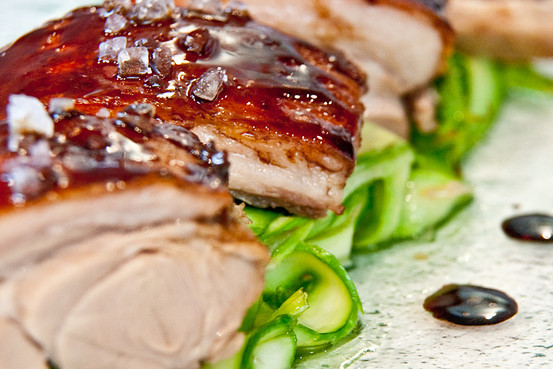Sous vide suckling pig
 |
|
[Photo/The Wall Street Journal] |
Singapore's Red Dot Traffic Building sits in the middle of the city-state's main business district and is known either as the former home to the traffic police, hence the cutesy name, or for the cluster of design firms that have their studios there. And tucked in the corner of this building is Otto Ristorante, helmed by Michele Pavanello, a creative in his own right.
The 111-seat restaurant is led by Mr. Pavanello, an Italian-born chef who has been in kitchens for 28 years, the last nine of which have been in Singapore. Before coming to Singapore, he worked at Villa Del Palazzo, a restaurant in Sun City, a resort in South Africa, as well as Harry's Bar in London.
Mr. Pavanello, who came to Otto two years ago and became a part-owner last year, says he's the first chef to introduce suckling pig - a piglet slaughtered when it is two to six weeks old - to an Italian restaurant's menu in Singapore. 'It's by far the most popular dish we make,' he says.
The 43-year-old's suckling pig is inspired by the Italian regions of Emilia-Romagna and Sardinia. He tells Scene Asia how he makes it:
Slow cooking: In Sardinia, suckling pig is usually made by digging a hole and roasting the piglet over burnt wood while bushes and soil cover the hole. In Emilia-Romagna, it's done by cooking the piglet in an oven. Here, he tries to mix both schools of cooking by placing the pork in a vacuum bag and cooking it slowly for 12 hours in a steam oven at 71°C (160°F). Mr. Pavannello says that this 'helps keep the juices even if you cook it for a long period of time. This gives it a sweet and sour flavor.'
Baby pigs: Mr. Pavanello sources his pigs from China. 'We used to get them from Holland, but they were too big and strong,' he says. 'If we get them from China, they only weigh three to four kilograms. They're more delicate, as they have no time to develop.'
Acacia honey: Acacia honey is a monofloral (derived from the pollen of one species of plant) form of honey extracted from black locust trees in the Himalayas. Mr. Pavanello says he picked this honey because it comes with a light taste and the 'particular flavor gives a different texture to the dish.'
Balsamic vinegar: Mr. Pavanello says that he prefers to get his ingredients from 'places as close as possible' to Singapore. Still, he picked this vinegar, which was made in northern Italy, because it has 'more depth' than other varieties. Before it is used in the dish, it was kept in barrels and aged for at least 12 years. 'I'm very familiar with this vinegar,' he says, 'It gives the dish a nice caramel taste.' The vinegar and honey are lacquered on with a brush after the piglet has been cooked.
Pan-fry: Cooking the pork in a bag in a steam oven ensures succulent meat but not a crispy exterior. To achieve a crunchy layer of skin, Mr. Pavanello fries the piglet in a nonstick pan 'with very little oil' for 10 to 15 minutes right before serving.






















